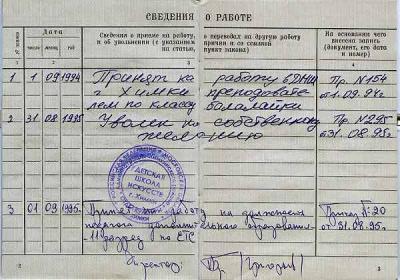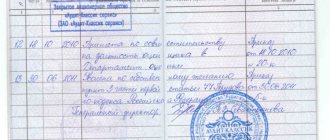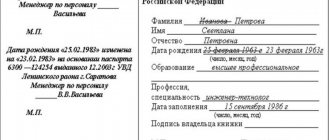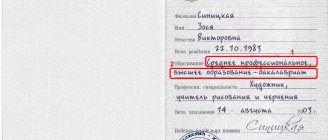20.07.2019
0
939
3 min.
Stamping in the work book upon dismissal is an important component of the proper execution of the document, which has certain rules established by current legislation. An incorrectly affixed stamp is a serious violation, and the personnel employee is responsible for this. For a dismissed employee, this will mean the loss of legal significance of the record on which the incorrect stamp is placed.
Regulatory documents and acts
The legislator, through his articles, tries to regulate the issue of stamping, but, unfortunately, these articles are not grouped into one section, but are scattered across regulatory legal acts in the labor sphere.
Thus, the most important document that formalizes all labor relations and aspects relating to them, namely the labor code , does not contain a separate article devoted to the affixing of a seal.
The Labor Code contains several references to the fact that any entry in the labor record must be made properly, and what constitutes a proper image is the concern of other legislative acts.
The rules for maintaining and storing work books, developed specifically for personnel officers, explain a little the situation with the seal. Paragraph 35 talks about which seal should approve the entries in the work book.
Letter of the Ministry of Labor No. 69 dated October 10, 2003 in paragraph 2/2 tells us quite clearly how the seal is placed on the title page
All other information presented in this article is nothing more than the many years of experience gained by the personnel department employees, which has become a kind of rule for filling out work books.
HR staff have special instructions. Recently, a sample work book has appeared in them, where you can see the place for the correct stamp.
But there is no direct guidance on how to apply a stamp. We hope that in the near future the legislator will correct this misunderstanding, making life significantly easier for the citizens of our country and young employees of human resources departments in organizations.
Why is a stamp placed on the TC?
The seal is of great importance, and any record certified by the stamp of the organization acquires legal force. Since the seal is with the employer, it means that the acts certified by it were examined directly by the employer and were approved by it.
Documents certified by a seal automatically become local regulations and are required to be read and followed.
Thus, the whole point of putting a seal in a work book is that the entry certified in this way is truthful and exists as a fact.
Stamps for work books
Records about transfers within the organization, part-time work, assignment of an additional profession, etc. do not need to be certified with a seal and signatures. Keep in mind that each entry made in the work book must be familiarized with its owner against the signature in his personal card in form No. T-2, in which the entry made in the work book is repeated (clause 12
Rules approved by Decree of the Government of the Russian Federation of April 16, 2003 No. 225). The form of the personal card was approved by the Decree of the State Statistics Committee of Russia dated January 5, 2004.
No. 1. Ivan Shklovets Deputy Head of the Federal Service for Labor and Employment Sample order on the introduction of seals in the organization "Alpha" INN 7708123456, KPP 770801001, OKPO 98756423 full name of the organization, identification codes (TIN, KPP, OKPO) ORDER No. 6 on the introduction and use of wax press of the city
When and in what cases is a seal applied?
The seal must confirm any action in the work book. But newcomers - HR department employees - probably do not know all the features and cases when exactly a stamp should be affixed. Let's study this information together.
The stamp is placed when filling out the title page . If an employee who does not have seniority and experience and, therefore, has no work experience comes to the employer to get a job, he must ask the employee to issue him a new work book.
There is nothing unusual in this request, since it is the employee who is responsible for creating a work record book for the employee. The work book contains information about the employee, namely:
- Name;
- surname;
- surname;
- Date of Birth;
- speciality;
- place of study;
- the level of education.
It is this information that is certified by the seal of the organization, that is, the authenticity of the information specified here is recognized. Is a stamp placed on the work book when applying for a job?
The stamp is placed on the employment record in the immediate employment form. Thus, the employment record is considered to have entered into legal force.
The record of the employee’s dismissal from his position is also Another case where a seal is used is a record of an internal or external transfer.
The seal takes place in the record of rewarding an employee or encouraging him. If the employee has improved his qualifications , a seal is also used to make an entry in the work book on a general basis.
And also in case of sewing in the liner .
Sample stamp in the work book:

Certification of the dismissal record in the work book, subtleties and pitfalls
So, the personal signature in the work book upon dismissal of the person responsible for the Labor Code (let it be an accountant) will look like this: In the case of an individual entrepreneur, whom Article No. 66 of the Labor Code was obliged to personally make entries in the document described, the signature will look like this : A lot of controversy arises over the question of the possibility or impossibility of reducing the words “individual entrepreneur” to two letters “IP”.
622 (St. Petersburg, Leningrad region); ext. 342 (Federal number). It's fast and free!
The only variability allowed is as follows: Of course, the last example does not fully meet the requirements of clause No. 3.22 of the above-mentioned standard (there is no job title), but in fairness it is worth saying that the Labor Code Rules do not indicate strict compliance with GOST requirements. In addition, the work book itself, with a big stretch, can be classified as documentation of an organizational and administrative nature.
What should it be like?
An organization can have from one to five stamps, which are used depending on their intended purpose.
But the most common types of seals are the general seal of the organization and the seal for documents . The latter, as a rule, is located by the personnel department employees. They are the ones who put this stamp on all incoming and outgoing documentation.
The general seal of the organization is usually kept by the employer. Only he puts it on all kinds of documents and forms that have official significance or are local regulations.
Many people wonder what kind of seal an employee of the HR department should have, is it possible to put a stamp on documents in the work book?
The answer to this question is simple - the work book is an official document, which means that the seal that is placed on the form must be the general seal of the organization . Printing for documents in this case is not suitable for printing.
If by mistake a document stamp was placed in the work book, this is a serious mistake and the entry must be redone.
Which stamp should I use?
- General seal of the organization
- Stamp “For documents” (Stamp of the HR department)
At the same time, in order to prevent any errors or inaccuracies, it is best to use one type of seal - the general seal of the employing organization. It is she who has greater legal force than the seal of personnel officers. It is advisable to put it on documents such as copies of work books, educational documents, certificates issued by the personnel department, extracts from work books, etc.
Where to put it?
The seal must have a clearly defined place on the pages of the work book. Depending on what information is included in the labor document, the location of the corresponding seal is determined.
If you need to put a stamp on the title page of the work book, you must first sign the employer. As a rule, the signature is placed in the lower right corner on the right side of the double-page spread. The signature is placed on top of the signature so that the signature is as much as possible in the center.
If we are talking about a form, then you need to put a stamp under the entry, preferably on the right side. The seal must be clear and not overlap the entry in the work book, thereby making reading the information problematic.
The employer's signature must be placed next to the seal. Thus, placing a seal is of decisive importance, because if you put it in the wrong place, it will either make it difficult to read the information from the work document and on the seal, or the distance between the seal and the record will be so large that it will be difficult to understand whether the seal refers to what is written in the work document or No.
That is why the personnel department pays so much attention to the place where the stamp is placed.
Don't put a stamp on your employment record anymore?
The seal is of great importance, and any record certified by the stamp of the organization acquires legal force. Since the seal is with the employer, it means that the acts certified by it were examined directly by the employer and were approved by it.
The following information is initially entered:
- Full name
- Date of Birth;
- speciality;
- place of study;
- the level of education.
This information is certified by the seal of the organization, that is, the authenticity of the information specified here is recognized.
What else is certified by the seal:
- Dismissal of an employee (record of dismissal)
- Transfer of an employee within the organization or to another organization
- Rewarding (encouraging) an employee
- Fact of advanced training
- Sewing the liner into the work
The seal of the organization or the seal of the HR department is placed on the title page of the work book during its initial registration. Before this, personal information about the employee is indicated on the title:
- his last name, first name, patronymic
- day, month and year of birth
- information about his receipt of appropriate education
- the name of the acquired profession or specialty.
After the specified data is entered on the first page of the work book, the employee signs, confirming the correctness of the data provided. Finally, all completed entries are signed by the person responsible for issuing work books and certified with a seal.
It should be noted that all personal information about the employee is filled out by an authorized person on the basis of relevant documents (for example, a higher education diploma, passport, driver’s license and others).
If we are talking about a form, then you need to put a stamp under the entry, preferably on the right side. The seal must be clear and not overlap the entry in the work book, thereby making reading the information problematic. The employer's signature must be placed next to the seal.
The organization's seal is affixed if the employee has changed his last name, first name, patronymic or other data. In this case, the previous entry is crossed out with one line and a new one is carefully entered, indicating the relevant documents, on the basis of which such changes are made. The authorized person puts his signature and seal on the back cover of the work book.
When dispensing the insert
From time to time, all available pages of any section of the work book become filled out. In such situations, the person involved in issuing and maintaining the relevant documents is obliged to issue an insert, which is valid only in conjunction with the work book. This procedure is entered into the work book and certified by a seal (stamp) with the inscription “Insert issued” indicating its serial and serial number.
Upon dismissal
When an employee is dismissed at his own request or for other reasons, the work book is signed by the head of the organization in which the employee worked, or by another person performing functional responsibilities for issuing work books and maintaining them, and directly by the employee himself. After this, the personnel department employee is required to put a stamp in the work book.
To avoid any questions about the validity of the document presented, the seal must partially cover the employee’s job title. At the same time, the employee’s signature and its transcript should be easy to read and not raise doubts. In addition, the seal impression must be clear, readable and clearly visible.
We invite you to familiarize yourself with: The procedure for registering land upon inheritance
From April 7, 2015, organizations can stop using round seals. They acquired this right after the Federal Law of April 6 came into force. 2015 No. 82-FZ. From this date, LLC and JSC have the right to independently decide whether to have a seal.
But is it necessary to put stamps in work books? This question worries many personnel officers and accountants. Moreover, this issue is also important for workers. After all, many will be very unhappy if there are no stamps in their work books.
The conclusion of the legal department of the Federation Council on the above-mentioned law states that its legal consequence should be the simplification of business document flow “taking into account the widespread increase in the use of electronic signatures.”
The obligation of LLCs and JSCs to use a seal can only be established in federal law (paragraph 1, paragraph 7, article 2 of the Federal Law of December 26, 1995 No. 208-FZ, paragraph 1, paragraph 5, article 2 of the Federal Law of 02/08/1998 No. 14 -FZ). However, there is no requirement in federal laws to use a seal to certify entries in the work book. It turns out that organizations have the right not to put stamps on work books if they do not have a seal.
However, there are by-laws that oblige organizations to affix a seal on the title page and upon dismissal. These requirements include:
- in paragraph 1 of clause 35 of the Rules for maintaining and storing work books, approved by Decree of the Government of the Russian Federation of April 16, 2003 No. 225;
- paragraph 2 of paragraph 2.2, paragraph 2 of paragraph 2.3 of the Instructions for filling out work books, approved by Resolution of the Ministry of Labor of the Russian Federation dated October 10, 2003 No. 69
- letter of Rostrud dated May 15, 2015 No. 1168-6-1.
It turns out that the rules prescribed by Rostrud contradict the new Federal Law. In addition, both employers and their employees are still distrustful of the idea of the absence of stamps in the work book. This, many believe, reduces the “weight” of the document and gives rise to abuse.
Explanation of the Ministry of Labor
Is a stamp required in a work book? The Ministry of Labor decided to correct the ambiguity of the situation. Its specialists developed a draft order “On amendments to the Instructions for filling out work books.” It is proposed to make adjustments to subparagraphs 2 and 3 of paragraph 2 of the Instructions. Based on these changes, the Ministry of Labor also drew up a draft explanation of the Rules for maintaining and storing work books, producing their forms and providing them to employers.
Officials explain the following:
- if the organization does not have its own seal, then the presence of imprints on the first page of the work book is not required;
- the same rule applies to the certification of a record of dismissal (termination of an employment contract): if there is a seal - it is affixed, if the company does not have a seal - a stamp is not needed;
- Since April 7, 2015, an adequate replacement for a seal is considered to be the signatures of the parties: the employer (or his authorized representative) and the employee, certifying the records made during work in this organization.
The commented projects of the Ministry of Labor have not yet been officially approved (they have neither a number nor a date yet). However, it doesn't really matter. The fact is that organizations have the right not to affix stamps in work books from April 7, 2015 (that is, from the moment legislators allowed to abandon the use of stamps).
Thus, if the organization does not have a seal according to the charter, the employee does not have the right to require the employer to affix a seal in his work book.
Related Posts
Since we are talking about the concept of “signature,” let us turn for clarification of terminology to GOST 6.30 entitled “Unified system of organizational and administrative documents” (edition 2003). This document states that the requisites called “signature” must include:
- the title of the position of the person who signed the document;
- personal signature of the above person;
- Full name as a transcript of the painting.
Accountant φ Lokteva K.V.
Individual entrepreneur φ Kotov Yu.B.
A lot of controversy arises over the question of the possibility or impossibility of reducing the words “individual entrepreneur” to two letters “IP”.
The answer to troubling doubts lies in the Rules, which very clearly state the impossibility of any verbal abbreviations in the process of making an entry in a labor document (the only exception is initials).
Employer φ Prigozhin A.A.
Of course, the last example does not fully meet the requirements of clause No. 3.22 of the above-mentioned standard (there is no job title), but in fairness it is worth saying that the Labor Code Rules do not indicate strict compliance with GOST requirements.
In addition, the work book itself, with a big stretch, can be classified as documentation of an organizational and administrative nature. In other words, this GOST in our case is more of a recommendation than a rule.
The records were reviewed by φ Sidorov
The first significant drawback of such a record is the lack of initials, because often the “squiggle” of the signature may not closely resemble the employee’s last name. The second mistake is the wording that came almost out of nowhere: “I have become familiar with the records” or simply “I have become familiar.”
Why out of nowhere? Because in reality there is not a single regulatory document that would require the signature of a dismissed employee to be drawn up in this way.
Problems are possible
Often, various types of problems arise when setting up a seal. The information on the stamp was printed poorly, the print ended up in the wrong place by mistake, and some others.
Also, HR department employees who use a large number of stamps often confuse the stamps, and I can put one that is completely unrelated to filling out the work report.
We will also talk about what to do in such situations further.
The work book has the wrong stamp
It happens that an employee of the HR department makes a mistake and puts a completely unnecessary stamp under the entry in the labor record. The first thing to do in such a situation is not to panic, but rather to calm down and ask for advice from senior colleagues or refer to the information in the instructions for HR department employees.
An incorrect seal should not be crossed out. You simply put the next serial number and write the following phrase: “Record No. 1 is not correct . This phrase can also be written a little differently, there are a lot of variations. The most important thing is the sense that what was written earlier is not correct and plausible information.
Next, you need to enter the next serial number and rewrite the entry in which the invalid stamp was made. Place the stamp that should have been used when recording originally.
That’s it, the correction of the error is completed and the work can easily be sent to your personal file. The main thing is not to forget to first make an entry in the book of movement and storage of labor records that a mistake was made, but was immediately corrected.
See below for a sample print correction:

What if the seal is hard to see and unreadable?
If the seal you put is not readable, don’t be upset. There is always a way out. If there is practically no impression left at the place where the stamp was placed, then simply put ink on the stamp and print it again. No one will notice that the production was secondary.
If, nevertheless, the information from the first seal is visible and it is not possible to put the second one in the labor document without dirt, do not worry.
Soak the seal in paint and place the seal next to the unreadable one . Making an imprint with an unreadable seal is not considered an error, so rewriting the record is not necessary.
Errors when preparing a document
The following error is often encountered: the organization's seal captures the text or signature of the personnel officer (and it becomes difficult to read what is written in the copy) or is not in the place where it should be (fields marked by MP). Arrange the seal impression according to the rules.
Errors in copies are not appropriate. Also, corrections when writing wording are not allowed. An incorrectly completed work book will simply not be accepted from an employee, as it is invalid. If a mistake is made, re-copy the necessary pages and certify them properly.
More details: GOST R 7.0.97-2016. “National standard of the Russian Federation. System of standards on information, librarianship and publishing. Organizational and administrative documentation. Requirements for document preparation"











